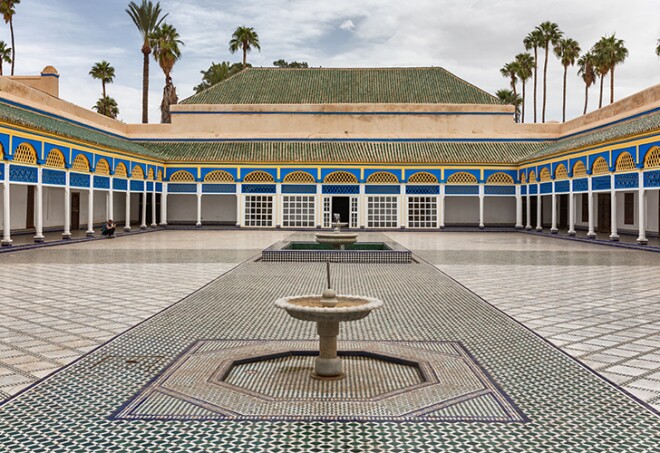Surely one of the most extraordinary imperial relics of Morocco, the Palais Bahia (“the brilliant”) doesn’t disappoint. Built at the start of the 19th century by architect El Mekki for Si Moussa, the then chamberlain of Sultan Hassan I, the palace showcases a wide range of architectural styles hinting at the chamberlain’s playful spirit, especially after his son inherited it and added his own brand of flamboyant glamour to the place. Women’s quarters bedecked with crimson-and-mustard–striped ceilings, a marble-tile courtyard the size of a soccer field, and extensive salons lined by stained-glass windows are just some of the features of the 20-acre space. In 1912, General Lyautey, the governor of French protectorate Morocco, moved in and added creature comforts such as fireplaces and central heating. In so doing, he attracted a number of illustrious guests, among them the writer Edith Wharton. She described the palace this way: “They came, they built the Bahia, and it remains the loveliest and most fantastic of Moroccan palaces. Court within court, garden beyond garden, reception halls, private apartments, slaves’ quarters, sunny prophets’ chambers on the roofs, and baths in vaulted crypts, the labyrinth of passages and rooms stretches away over several acres of ground.” Follow Wharton’s lead and don’t miss it.
More Recommendations
Morocco's Most Spectacular Palace
Surely one of the most extraordinary imperial relics of Morocco, the Palais Bahia (“the brilliant”) doesn’t disappoint. Built at the start of the 19th century by architect El Mekki for Si Moussa, the then chamberlain of Sultan Hassan I, the palace showcases a wide range of architectural styles hinting at the chamberlain’s playful spirit, especially after his son inherited it and added his own brand of flamboyant glamour to the place. Women’s quarters bedecked with crimson-and-mustard–striped ceilings, a marble-tile courtyard the size of a soccer field, and extensive salons lined by stained-glass windows are just some of the features of the 20-acre space. In 1912, General Lyautey, the governor of French protectorate Morocco, moved in and added creature comforts such as fireplaces and central heating. In so doing, he attracted a number of illustrious guests, among them the writer Edith Wharton. She described the palace this way: “They came, they built the Bahia, and it remains the loveliest and most fantastic of Moroccan palaces. Court within court, garden beyond garden, reception halls, private apartments, slaves’ quarters, sunny prophets’ chambers on the roofs, and baths in vaulted crypts, the labyrinth of passages and rooms stretches away over several acres of ground.” Follow Wharton’s lead and don’t miss it.
A Placid, Empty Palace in the Marrakesh Medina
Visiting the 19th-century Palais de la Bahia is one of the best ways to escape the hurly-burly of the Marrakesh souks; meandering through the tiled courtyards of Dar Si Moussa, the older of the 20-acre, cat-prowled compound’s two buildings, I could practically feel my addled nerves unwinding. The rooms were ransacked long ago, making it easier to appreciate the beautifully painted wood doors and ceilings. The Palais de la Bahia has an emptied-out, contemplative vibe that I actually really liked. There are plenty of other places in Marrakesh to go treasure-hunting.
Romantic photo opportunities
The warm Moroccan light and the red and pink ochres of the buildings make Marrakesh and endlessly photogenic city. That said, there are some essential self-portraits that everyone needs to bring back from their trip: in front of the Koutoubia minaret, framed against the intricate tiled decoration of the Bahia Palace or the Ben Youssef Medersa, lost amid the foliage of the Marjorelle Gardens, and enjoying either a mint tea at a street café or a stronger sundowner on the roof terrace of a riad. Those of a nervous disposition may want to avoid the snake charmers who attempt to coil their serpent charges around the neck for another classic tourist pose.
Admire the Splendor of Marrakesh’s Imperial Palaces
Marrakesh is one of Morocco’s four great imperial capitals, and its rulers made sure they left behind plenty of evidence of their grandeur. Most impressive of all is the Bahia Palace, built for a 19th-century grand vizier to the Moroccan sultan. It’s a master class in the fine Moroccan arts—zellij mosaic floors, carved stucco plasterwork and painted cedar ceilings, around a serene garden. The huge El Badi Palace has fared less well over the centuries, and is more a magnificent ruin, with sunken gardens and a massive pool. Its rulers are buried nearby in the opulently decorated Saadian Tombs.























